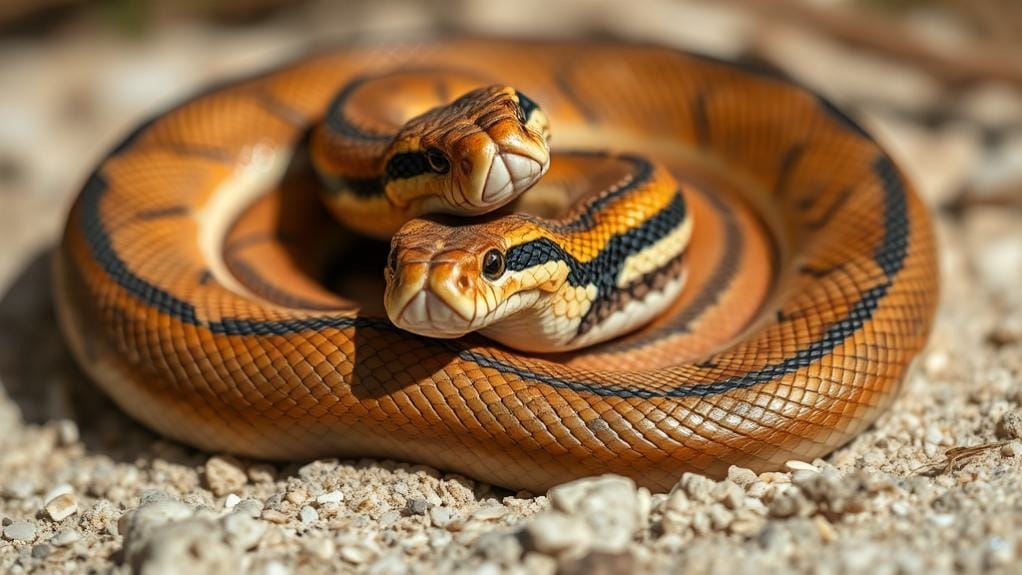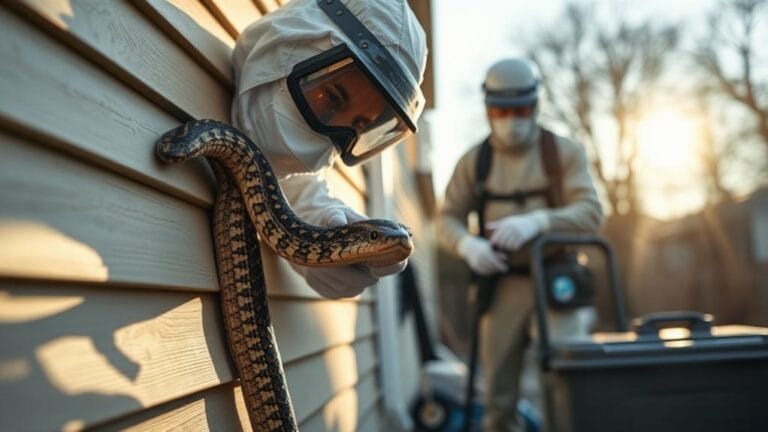Want to breed snakes? You'll need to nail the basics first. Success depends on creating the perfect environment – we're talking temperatures between 78-88°F and humidity at 50-70%. You'll need to watch for key signs like post-winter shedding and changes in appetite that show your snakes are ready to mate. During breeding season, females need more food while males might fast. Keep an eye on their health with regular checkups and provide plenty of hiding spots. Most importantly, don't rush the process – proper timing and patience are essential. There's a whole world of snake breeding knowledge waiting for curious keepers like you.
Preparing Your Snake's Environment
Table of Contents
Success in snake breeding starts with creating the right environmental conditions.
Let's get your snake's home ready for some serious romance – and trust me, it's more complex than just dimming the lights and playing smooth jazz. Consider using natural snake repellents around the perimeter of your breeding area to keep wild snakes away during this sensitive time.
You'll need to nail those temperature and humidity levels like your snake's love life depends on it (because it does).
Start by gradually lowering temperatures a few degrees each month. Think of it as nature's dating app – it signals breeding season is approaching.
I can't stress this enough: maintaining the right humidity between 50-70% is essential.
You'll also want to scatter proper hiding spots and nesting materials throughout the enclosure. Trust me, your snake needs its privacy!
Pro Tip: *Monitor environmental factors daily. One wrong temperature swing and you might as well cancel the whole breeding process.*
Signs of Breeding Readiness
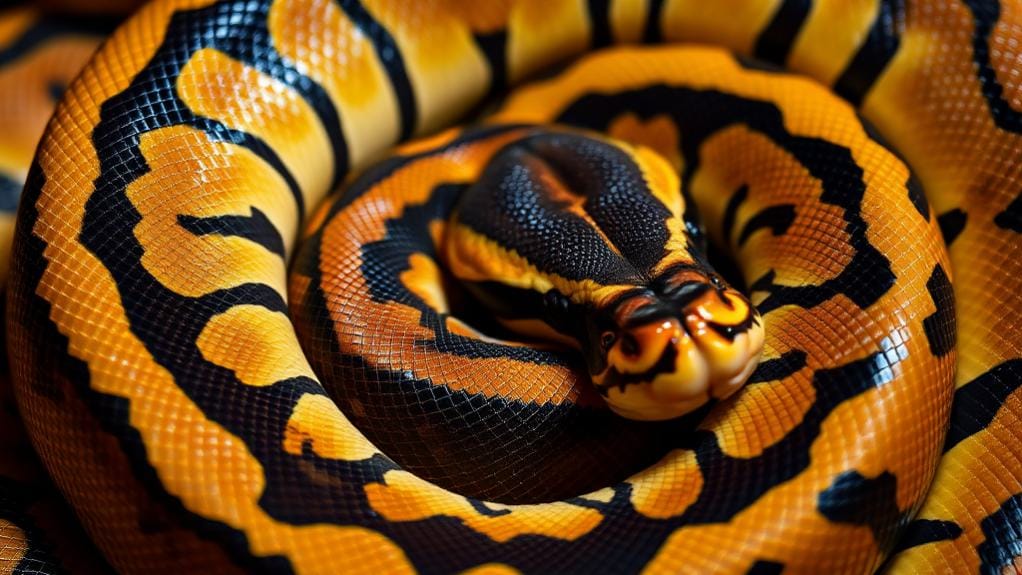
Recognizing breeding readiness in snakes requires careful observation of both behavioral and physical changes. I'll tell you exactly what to watch for – and trust me, you won't miss these signs once you know what they mean!
During breeding season, you'll notice your male snake turning into quite the Romeo. You may want to place snake traps nearby if you're concerned about unwanted breeding activity in your area. He'll show off with tail vibrations and those fancy combat dances.
Meanwhile, female snakes get down to business by releasing pheromones that basically scream "I'm ready!"
Key signs to watch for:
- Post-winter skin shedding (yep, it's like their version of date-night prep)
- Refusal to eat or reduced appetite in both sexes
- Females getting thicker around the middle
- Males becoming more active and aggressive (they're not being jerks – it's just nature!)
*Pro tip: When females start releasing those come-hither pheromones, males won't exactly play hard to get.*
Temperature and Humidity Control
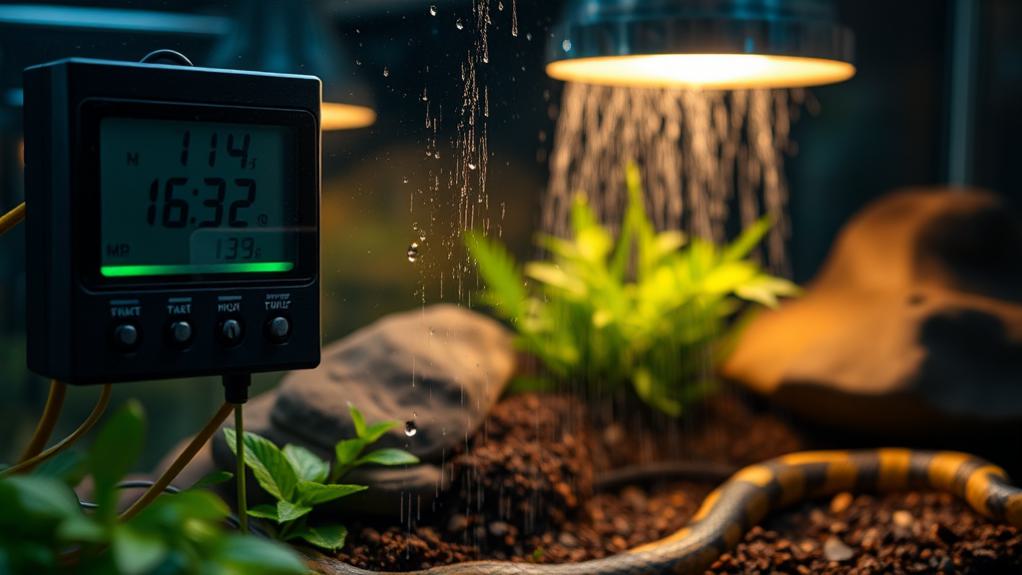
A thermometer and hygrometer are your best friends during snake breeding season. Just like during winter brumation activity, careful temperature monitoring is essential for snake health and behavior.
Trust me – if you can't maintain proper temperature and humidity levels, you might as well kiss successful breeding goodbye.
For healthy snake breeding, here's what you absolutely must nail:
- Keep incubation temperature between 78-88°F (and yes, those numbers matter)
- Maintain humidity levels at 50-70% for proper hydration
- Set up a hot zone to boost metabolic activity
Pro tip: Northern species need gradual cooling for brumation, but don't go crazy with environmental temperature changes for tropical snakes – they're drama-free that way.
Remember: Consistent monitoring is vital. If you think you can eyeball temperature and humidity without proper tools, I've got a bridge to sell you.
Your snake's breeding success depends on getting these basics right.
Dietary Requirements During Mating
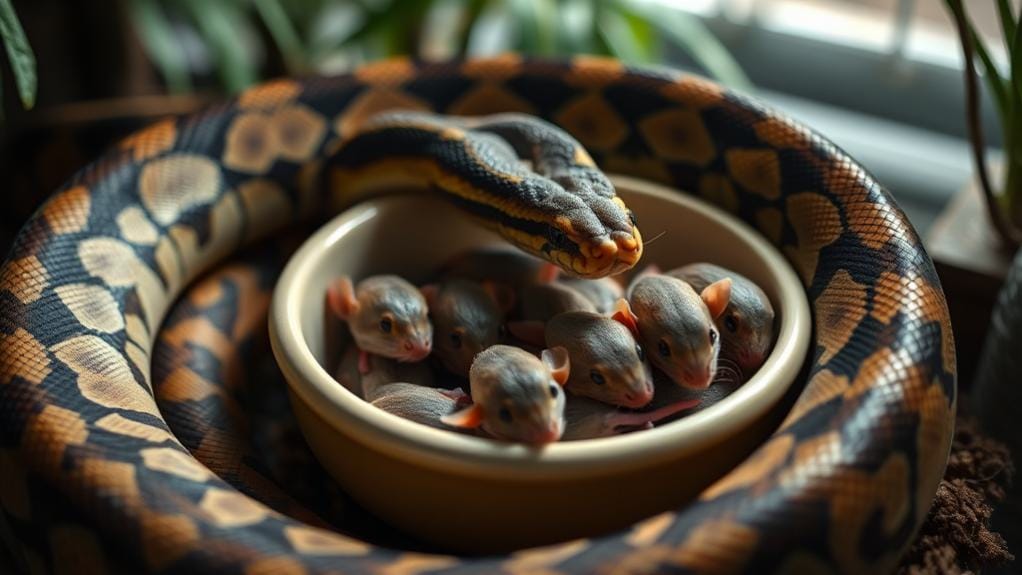
Proper feeding during snake breeding season can make or break your success as a breeder. I'll tell you straight up – a nutrient-rich diet is non-negotiable for reproductive performance. You'll need to carefully monitor your female snakes since they might get picky eaters during mating season.
| Snake Type | Feeding Frequency | Special Notes |
|---|---|---|
| Males | Reduce if near females | May fast – separate if needed |
| Females | Increase | Monitor closely |
| Both Sexes | Regular schedule | Health assessments essential |
Let's get real – your whole prey choices better be on point. I'm talking perfectly sized mice or rats for a balanced diet. And don't even think about skipping those health assessments. Trust me, you don't want to discover health issues mid-breeding season when it's too late to fix them.
*Pro Tip: Keep males away from female pheromones if they're refusing meals. No one likes a hangry snake!*
Monitoring Mating Behavior
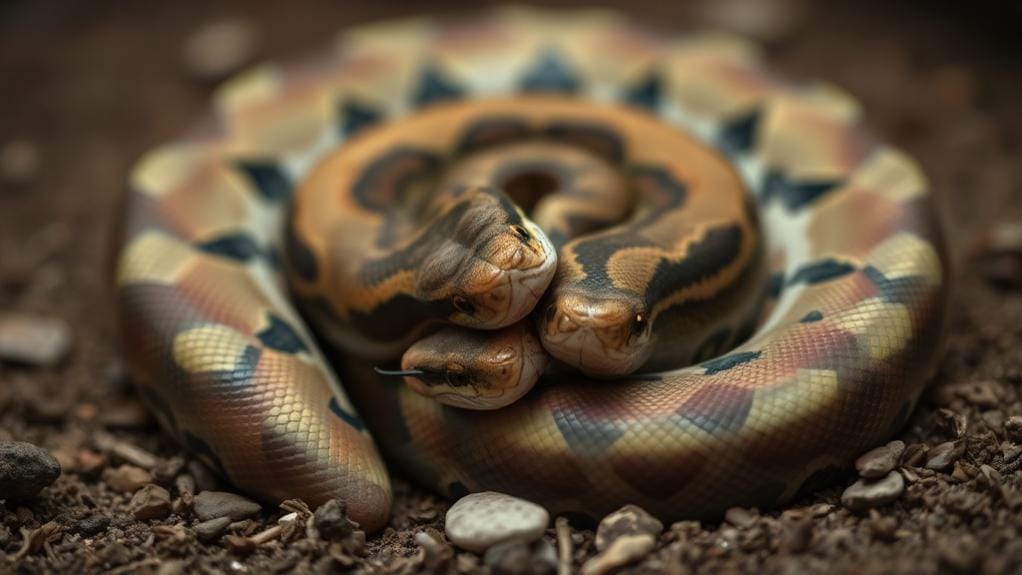
When it comes to snake breeding, feeding isn't your only focus – you've got to keep a sharp eye on mating behaviors too.
Trust me, monitoring your snakes during the breeding process is vital unless you want reptilian drama on your hands. Understanding natural snake behavior and predator patterns can help predict ideal breeding conditions.
Here's what you need to watch for:
- Female snake releasing pheromones (yeah, snake perfume is a thing)
- Males doing their combat dances – it's like a scaly dance-off
- Changes in female behavior, especially restlessness and that telltale midsection thickening before ovulation
Pro Tip: Keep those courtship behaviors under control! If you notice aggressive behaviors or signs of stress like hissing or striking, separate them immediately.
Your job is to track these interactions closely.
Think of yourself as a snake relationship counselor – except your clients are less likely to take your advice.
Health Considerations While Breeding
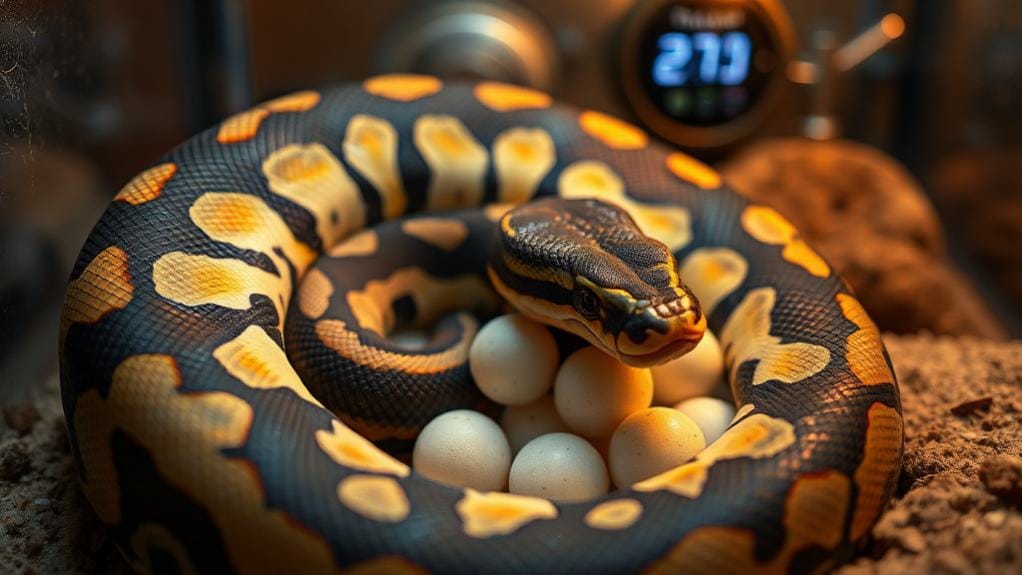
Throughout breeding season, maintaining your snakes' health becomes more essential than ever. Regular health checks are your best friend – trust me, you don't want to deal with a sick snake during this vital time.
Keep an eye on appetite changes and any unusual behaviors. Just like terrier breeding concerns require careful monitoring, snake breeding demands consistent health supervision.
Here's what you absolutely must monitor:
- Males need their beauty rest between breeding attempts (yes, really). Don't let them overdo it, or their reproductive effectiveness will tank.
- Female weight monitoring is essential – she needs those fat reserves for embryo development. A skinny mama snake won't cut it.
- Watch for stress in females. If she's getting snippy or playing hide-and-seek more than usual, something's wrong.
*Pro Tip: Don't play amateur vet. When in doubt, get a veterinarian consultation. It's cheaper than replacing breeding stock.*
Post-Mating Care and Support
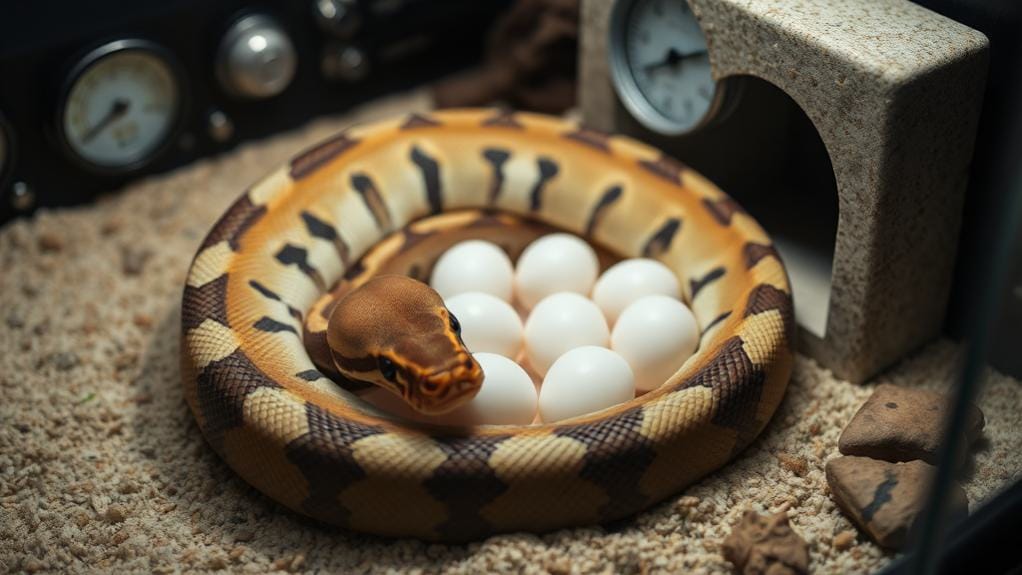
Taking care of snakes right after mating calls for quick but careful separation of the pair.
Trust me, you don't want to deal with stressed-out snakes giving each other the side-eye. It's essential for post-mating care to give them space to recover.
Now, let's focus on your female snake – she's the star of the show.
You'll need to:
- Monitor pregnancy signs like swelling (yes, snake baby bumps are a thing)
- Set up a cozy nesting area with a damp substrate hidebox
- Run regular health checks – because nobody wants a grumpy expectant mother
- Maintain ideal environmental conditions
Pro Tip: Keep temperature and humidity levels perfect for egg-laying success. Your female snake isn't going to fill out a complaint form – she'll just let you know by refusing to lay eggs.
Remember: Support = Success. It's that simple.
Frequently Asked Questions
What Do You Need to Know to Be a First Time Snake Owner?
I'll tell you that proper research is essential. You'll need to understand your snake's specific habitat needs, temperature requirements, feeding schedule, and healthcare basics. Always keep an eye on behavior changes.
What Time of Year Do You Breed Snakes?
I'll tell you that spring is the prime time to breed most snakes, as they're naturally stimulated by warmer temps and longer days. Though some species also breed in fall, depending on their specific needs.
Is Snake Breeding Lucrative?
I'll tell you honestly: snake breeding can be profitable but isn't guaranteed. I've seen success require patience, expertise, and investment. It's risky – you'll need market knowledge and dedication to make it work.
Do Snakes Eat During Breeding Season?
I'll tell you that most snakes reduce their eating during breeding season. Female snakes might eat small meals until late pregnancy, while males often stop eating completely when they're focused on mating.
Last Word
Just like Romeo and Juliet's passionate tale, snake breeding isn't for the faint of heart. I've seen too many owners jump in without proper prep – don't be that person. You'll need patience, precise control, and constant monitoring. Trust me, it's more science than snake soap opera. If you're ready to commit to the process I've outlined, you're on track for successful breeding. If not, stick to one snake and save yourself the drama.

